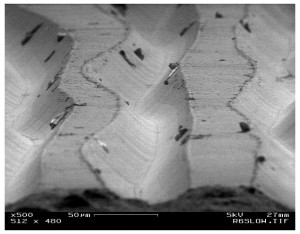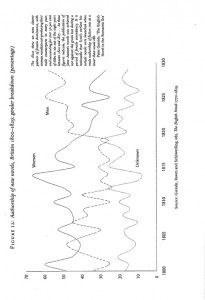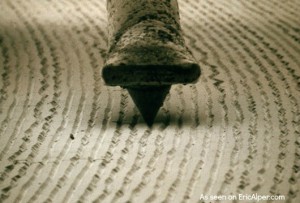The post Probe: Phonographs, Maps, Carpentrees appeared first on &.
]]>On what scale is Chang’s a scalar reading project? How does a noisy audio palimpsest multiplying “one” object compare with the pristine genre-spanning graphs of Moretti or the intricate Göethe-corpus topologies cited by Andrew Piper?
It’s tempting to dismiss Chang’s White Album remix as simply the synchronic equivalent of a less sophisticated “vernacular” of distant-reading like the supercut. But Ian Bogost’s proposal that object-oriented ontologists need to graduate from the logocentrism of writings which do ontology in theory, to the carpentry of crafted objects that put ontologies into practice (e.g. 91-2), suggests that graphing-objects similarly needn’t be constrained to the logo-visual. Can the “palimpsest” component of Chang’s clearly praxis-oriented project be considered, then, as “auditorizing” data in the same way that one of Moretti’s graphs visualizes data? A pertinent question, given “today’s growing interest in the field of information visualization” (Piper 388).
After all, what is graphic representation? “Graphing,” as the etymology suggests, is a form of writing, which is a form of drawing. As Piper points out, “Friedrich Kittler’s argument, of the two-thousand-year-old antipathy between the alphabetic and the numerical[,]” is a “false notion” (380). Nonetheless, the invisible Cartesian latticework gridding any typeset page, into whose discursive position of “prose” most writing gets indifferently wrapped, has continuously disarticulated graphemic writing from the genre of alphanumeric graphical representation. Notably the same, however, cannot be said for music. From its earliest forms, well before Descartes and de Fermat, the musical staff makes little secret about its dimensionality: pitch vs. time. But: “non-musical” texts encode sound no less! They, too, graph sounds against time, within a limited repertoire of graphemes (e.g. 26 letters vs. 12 tonic pitches). Thus, while literary analysis may have preoccupied itself with “the two-dimensionality of the page or the three-dimensionality of the book” (Piper 383), its broader problem has been that it would not even have articulated its conceptions of the page and book as such, for only recently has it begun to consider its objects in dimensional terms whatsoever. Meanwhile, graphing (alphabetic writing) and graphing (alpha-numeric charting) and graphing (musical scoring) have remained distinct. And a musical graph is expected to be performed aloud, with the body, whereas a philosophical or statistical graph is expected to be performed in silence, with the head. Cartesian plane indeed.
Sound, in short – by which I don’t mean speech – has been systemically excluded as a medium for philosophy, let alone for demonstrative data representations, and this has everything to do with philosophy’s logocentric tradition in emphasizing content over form, music being strongly articulated to the latter. But if we re-articulate the above various forms of writing as graphings more broadly, can we then likewise re-articulate any performance of a graphing as itself a form of graphing, even if this performance is sensually other to the visual (as the iconized data of Piper and Moretti, despite their iconoclasm in other respects, tends to emphasize)?
Things become clearer if we elaborate further on what graphing (i.e. writing) is, and illustrate with vinyl. In Vilém Flusser’s description, “writing…was originally an act of engraving. The Greek verb ‘graphein’ still connotes this…. [T]o write is not to form, but to in-form, and a text is not a formation, but an in-formation” (Roth 26). It is such information that we find grooving a vinyl record: a form of information whose curves, unlike these graphemes that I type, is more readily articulable to the curves of information that discourse has arbitrarily distinguished as graphing (see Figs. 1 & 2). Indeed, confusions have arisen at all because we speak of information in such logocentric terms as Flusser himself does, whereas information theorists speak of it in terms of waves, frequencies – something that writers like Piper do evoke with statements like, “any textual field is at base a configuration of differential repetitions” (394). Whereas, now that we’ve re-articulated graphing as information, we can see how the curves of Figure 2 could just as easily be transfigured into audio as could the curves on the vinyl. It would be up to us listeners to re-articulate our logo-visual biases to interpret the “audiograph” as well as we can its visualized score. But is it just our lack of familiarity with interpreting an “audiograph” as a graph that would other it as comparably “messy” (in John Law’s term), or can such graphs simply not compare with pristine Cartesian visuals, say for reasons of transfiguration?
The approach to this question is rolled up in what the convergence of Figures 1 and 2 illustrates: the zero-point at which “distant” and “close” break down into “a continuous spectrum of focalization” (Piper 382). This is a useful place to begin discussing Chang, whose “1 x 100” audiograph intuitively seems more of a “distant reading” than the audiograph from a single record. But, having dismissed the distant-close binary in favour of an ontology of surface relations, we shall see that “more” no longer necessarily means more, nor “less” less. If all graphs record regularities of information, then the question becomes not about perspectival proximity, nor even exactitude, but about how and what each object – 1 White Album vs. 100 White Albums simultaneously – graphs differently. What do the regularities of one single White Album measure in comparison with the overlayed regularities of one hundred White Albums?
Close-distant reading: We needn’t hear 100 versions at once for us to know that our single copy is not singular, that the “object” we listen to is much larger than its packaging’s pretense to unity; indeed, the fact that it is not one-of-a-kind is likely how and why we and the object found each other in the first place. For Foucault, the very fact that we have a White Album playing at all means that it is discursively sanctioned, corresponding to a discursive statement, a regularity within a field of discourse: the grooves of a single White Album already graph a regularity concerning White Albums. Like the statement “QWERTY,” produced by a standard keyboard, any printing of a White Album is a statement produced by a similarly standardized mass-printing device programmed to print the White Album from a “master” copy or image, such that any single vinyl record graphs a regularity of discourse, a record of the process of inscribing White Albums with the grooves that constitute White Album-ness. A White Album graphs, more accurately than its hundred-fold multiplication, the pristine Gaussian “mean” of White Album articulation. Mass production’s claim to mass identity is its mass delusion, but an individual album is nonetheless a graphical index of its mass-media ur-stamp. Indeed, this is so because it is such standardization’s goal: to distribute the closest approximation of the Same, so that a claim for Sameness may be made, a common-place created.
Distant-close reading: What do the 100 albums played at once tell us, then? We needn’t listen to know that there will be much “noise”; indeed, judging by the present recording, if Chang carries through with his plan to mash up his 600+ records, we would hear nothing but noise. What, then, does this audio-topography do? Ostensibly it graphs the relative fluctuations between 100 versions – but not in any distinct way. Can we distinguish all the tracks (and their interrelations) as we might in a visual representation? Indeed, there is “noise” because there is information lost – each element in the audiograph interferes with every other. Or is the noise we perceive as much a function of our bias to the logo-visual? If for topology “the ‘object’ is merely the identification of a visual thickness” (Piper 384), then Chang’s project fits the description, but does this hold if topology considers “reading” only as “a deeply visual experience” (Piper 387, emphasis added)? Alternatively: Friedrich Kittler engages in an alien phenomenology of the phonograph to describe its recordings as constituting the real: “The phonograph does not hear as do ears that have been trained immediately to filter voices, words, and sounds of noise; it registers acoustic events as such. Articulateness becomes a second-order exception in a spectrum of noise” (Kittler 23). Such engagement raises the question: Is (topo)graphing unable to deal with acoustic events as such? Would the noise be better approached from the phenomenology of an alien object?
Works Cited
Bogost, Ian. “Carpentry.” Alien Phenomenology, or, What It’s Like to Be a Thing. Posthumanities. Minneapolis: University of Minnesota Press, 2012. 85–111. Print.
Roth, Nancy A. “A Note on ‘The Gesture of Writing’ by Vilem Flusser and The Gesture of Writing.” New Writing: The International Journal for the Practice and Theory of Creative Writing 9:1 (2012): 24-41. Web.
Kittler, Friedrich A. Gramophone, Film, Typewriter. Trans. Geoffrey Winthrop-Young and Michael Wutz. Stanford UP: Stanford, 1999. Print.
Law, John. “Making a Mess with Method.” Lancaster: The Centre for Science Studies, Lancaster University, 2003.
http://www.comp.lancs.ac.uk/sociology/papers/Law-Making-a-Mess-with-Method.pdf
Moretti, Franco. “GRAPHS, MAPS, TREES: Abstract Models for Literary History – 1″. New Left Review 24 (Nov-Dec 2003): 67-93. Web.
Paz, Eilon. “Rutherford Chang – We Buy White Albums.” Dust and Grooves: Vinyl Music Culture. 15 Feb 2013. Accessed 10 Oct. 2013. http://www.dustandgrooves.com/rutherford-chang-we-buy-white-albums/
Piper, Andrew. “Reading’s Refrain: From Bibliography to Topology.” English Literary History 80 (2013): 373-399. Web.
The post Probe: Phonographs, Maps, Carpentrees appeared first on &.
]]>The post game art, glitch, psychogeography. appeared first on &.
]]>I’ve finally figured out my course work for the year, which has been challenging due to being a student in the INDI program. Without any required courses or parent discipline, I often found myself unable to register for certain courses because of the fact that several were mandatory for other programs. Thankfully though, that it done, and I find myself with two games studies courses, a course on media history and historiography, and a directed reading on psychogeography and peripatetics in literature. I’m excited for the year for several reasons, one of which has to be the fact that even though my MA was technically focused on game studies, that I have not taken a single course on the subject. The media history course is exciting due to my MA thesis work in alternate historical narratives centred on digital gaming platforms. Finally this directed reading will start my research into the historical traditions of psychogeographical practices in literature, which is part of the foundation I need to move forward with my PhD research linking these practices with those found in digital games.
Meeting with Andre Furlani, the English professor I’ll be doing my directed reading with, was a great experience. We discussed what I knew about psychogeographic literature, how I thought of its relationships with games, and my specific interest in its intersection with digital architectures and ludic cartography. It was one of those meetings where we were both so energized by the conversation, that we (at least I) didn’t really want it to end.
With the usual beginning of the year tasks out of the way, I’ve turned my attention to something to settling into the city, getting out and exploring, and visiting as many galleries as I can. One of the most exciting exhibitions I discovered was a Cory Arcangel retrospective currently on display at DHC ART in old Montreal. The show spans the work from his career, from video pieces, game hacks, sculpture, image, etc. Having a particular preoccupation with game art, I was eager to see what the exhibition had on offer.
The exhibition featured Arcangel’s ROMhack of the Nintendo game Hogan’s Alley, now called I Shot Andy Warhol. Displayed on an original NES with the Zapper (lightgun) accessory, gallery visitors could play the game on an old CRT television. In this game you must “Shoot Only Andys” and not the other pop culture icons that Arcangel has included in the game: The Pope, Colonel Sanders, and Public Enemy’s Flava Flav. It’s a fun, cheeky piece about celebrity culture and worship. Compounded by the fact that the piece is off in it’s own small space, feeling like a secluded confessional box.
Self Playing N64: NBA Courtside 2, is an interesting piece that combines automation, games and failure in an interesting way. Using a custom circuit board to modify a Nintendo 64 controller, Arcangel created a system for automated gameplay, removing the player from the equation. This modified system plays the game NBA Courtside 2‘s free throw mini game, featuring Shaquile O’Neil attempting to land a shot in the basket. However instead of creating a form of automation that would see successive shots landed, the system was designed to ensure a missed shot every time. The mini game is looped on itself, with the sounds of a basketball hitting the floor rhythmically, filling the room in the gallery. The idea of the automating failure is a common theme in Arcangel’s work, as he tends to create works which often bend and break the digital media that he is using in his artwork. Here’s a 7sec video I took of the piece (7sec is like Vine, but with a whole extra second of footage!)
The final game related work that was on display at the exhibition was Super Mario Clouds, which is, perhaps, Arcangel’s most famous work. A ROMhack of the original Super Mario Bros. for the NES, SMClouds removes all elements from the game, except for the clouds in the game, which then languidly move across the screen. By subtracting all of the other elements, SMClouds poses interesting questions on the nature of the medium of games and states of play. The game is no longer played but it rather played back, much more like a film or video. It highlights the underlying structures of ludic conditions within a game by removing them outright. While the piece itself is still one of my favourites, I have to say that I am disappointed by the installation at DHC. I have seen images of other SMClouds installations, and the DHC install seems, underwhelming by comparison.
Here is an image of the piece being shown at the Whitney Museum of American Art in New York:
And here are photos I snapped of the installation at DHC:
While I feel like I understand what curator John Zeppetelli was trying to accomplish here, I feel that it lacks any real aesthetic that does justice to this piece. I get that placing it above the line of sight of visitors that the install asks us to look skyward, much like we would do if looking at real clouds. However, I look at this and can’t help but think of televisions installed in classrooms, large hulking beasts bolted to the walls for so-called security. I feel like it distracts from the piece, rather than highlighting it.
————————————————————–
Other than gallery hopping (this week I plan on going to the Contemporary Art Museum, and the Canadian Centre for Architecture), I’m reading Peter’s Ackroyd’s London Under, a fascinating recantation of the city that exists under the city. I’ve also begun getting back into creative production. Working on a new maquette for a large scale sculpture project which relates to the creation side of my dissertation work, as well as getting back into some digital manipulations such as game circuit bending and cartridge pulling. Here’s a sample of what my bending endeavours have gleaned so far.
Otherwise, excited and raring to go for coursework, and getting back into the swing of things, academically speaking.
The post game art, glitch, psychogeography. appeared first on &.
]]>








